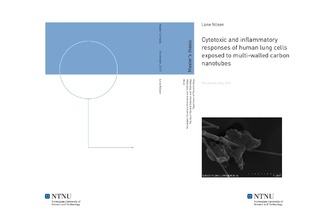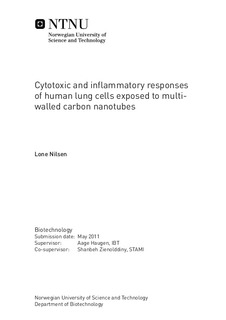| dc.description.abstract | AbstractWith the emergence of the nanotechnology industry, there has been a rapid expansion of different types and numbers of nanomaterials to be used in various applications. However, little is known of their potential to cause harmful effects on human health. Among other nanomaterials, carbon nanotubes, are found to harbor attractive characteristics that can be used in many applications. However, the same properties may cause harmful effects on human health that has raised serious concerns. The main route of exposure to carbon nanotubes is through the respiratory system with subsequent deposition in the lungs. Carbon nanotubes in contrast to other nanomaterials have fiber-like structures similar to the asbestos fibers. Exposure to asbestos has been associated with serious lung diseases such as fibrosis and cancer.A common type of carbon nanotubes called multiwalled carbon nanotubes has many valuable properties and several potential applications in different nanoproducts, manufactured commercially. It seems that the toxicological effects differ from product to product. Through this study potential harmful effects of two multiwalled carbon nanotubes designated as MWCNT-NO (produced in Norway) and MWCNT-JP (produced in Japan) have been investigated in vitro in normal human lung cells. The well known crocidolite asbestos was included to compare the effects with nanotubes. Hydrogen peroxide, a well known oxidative agent was also included since it has been hypothesized that carbon nanotubes may exert their effects through oxidative stress mechanisms. Cellular responses such as cytotoxicity, apoptosis and changes in expression of some inflammatory and apoptotic genes were studied. The results of the cytotoxicity assays (WST-8 assay) indicated a reduction of cell viability for carbon nanotubes and crocidolite asbestos, depending on the dose and time of exposure. However, MWCNTs, especially MWCNT-JP, were more toxic than crocidolite asbestos. For the hydrogen peroxide, the reduction in cell viability tended to depend only on the dose. Little differences between the two cell-lines were observed. Hoechst/PI staining revealed that cell death occurred essentially by necrosis and not apoptosis following exposure. Exposure to MWCNT-NO resulted in an increased expression of the IL1B, IL8 and IL6 inflammatory genes (qRT-PCR). This differed from the MWCNT-JP type where little changes in the expression were observed. Some differences between the two cell lines were also observed. The overall potential of the tested carbon nanotubes to cause harmful effects in normal human lung cells needs further verifications with improved particle characterization. | nb_NO |

